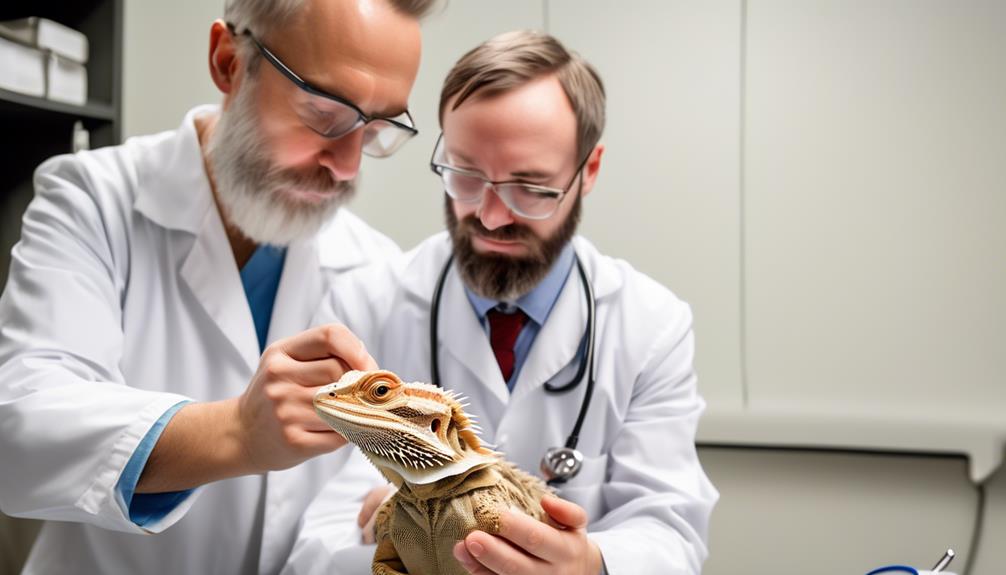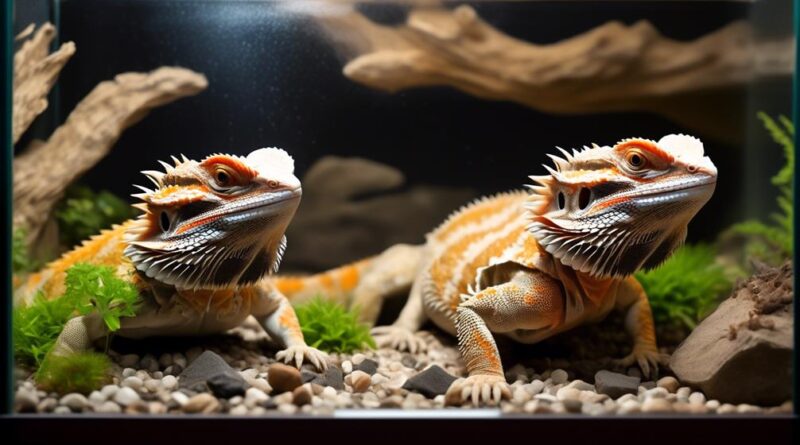What Factors Should Be Considered for Bearded Dragon Breeding?
Considering breeding bearded dragons?
Have you ever wondered what factors are crucial for successful breeding?
Breeding these captivating reptiles involves more than just putting a male and female together. From genetics and morphology to egg incubation and hatchling care, there are numerous factors to consider.
Understanding these factors is essential for ensuring the health and well-being of both the breeding pair and their offspring.
Let's explore the key elements that play a pivotal role in bearded dragon breeding.
Genetics and Morphology
Understanding the genetics and morphology of bearded dragons is essential for successful breeding and maintaining healthy populations. When considering breeding pair selection, it's crucial to analyze phenotypic traits and genetic inheritance to predict the offspring's characteristics.
Phenotypic traits, such as color, pattern, and body size, are observable characteristics that result from the interaction of genetic and environmental factors. By conducting morphological analysis, breeders can assess these traits to identify desirable characteristics for breeding purposes.
In breeding bearded dragons, genetic inheritance plays a significant role in determining the traits passed down to the offspring. Traits can be inherited through dominant, recessive, or co-dominant genetic patterns. Understanding these inheritance patterns is vital when selecting breeding pairs to achieve specific phenotypic traits in the offspring.
For instance, if a breeder aims to produce a certain color morph, they must consider the parent's genetic makeup to predict the likelihood of obtaining the desired offspring traits.
Morphological analysis, including the examination of physical features and body structures, aids in identifying desirable traits for breeding. By carefully evaluating the morphology of potential breeding pairs, breeders can make informed decisions to enhance the overall health and quality of the offspring.
Additionally, understanding the genetic and morphological aspects of bearded dragons contributes to the conservation of diverse traits within the captive population, ensuring the sustainability and genetic diversity of these fascinating reptiles.
Breeding Age and Size
Breeding age and size are crucial factors to consider when selecting bearded dragon pairs for mating, as these traits directly impact the health and success of the breeding process. When determining the appropriate breeding age and size for bearded dragons, several important factors should be taken into account:
- Reproductive Readiness: Bearded dragons reach sexual maturity at different ages depending on their individual growth rates. Typically, females are considered reproductively mature when they reach 18 months to 2 years of age, while males may reach maturity at around 8 to 12 months. It's important to ensure that both male and female dragons have reached the appropriate age and size before attempting to breed them to prevent potential health complications.
- Hormonal Changes: As bearded dragons approach sexual maturity, hormonal changes occur within their bodies, influencing their mating behavior. Male dragons may become more territorial and display increased aggression, while females may exhibit receptive mating behaviors. These hormonal shifts signal that the dragons are reaching breeding age and readiness.
- Growth Rates: Monitoring the growth rates of bearded dragons is essential for determining their readiness for breeding. It's crucial to ensure that both males and females have reached a healthy size and weight before introducing them for mating. Premature breeding can lead to stunted growth and health issues in the offspring.
Habitat and Enclosure Setup
When preparing the habitat and enclosure for breeding bearded dragons, ensure that the setup provides adequate space and environmental conditions for the well-being of the mating pair. Bearded dragons require a temperature gradient in their enclosure, with a basking spot reaching around 95-100°F (35-38°C) and a cooler side around 75-85°F (24-29°C). This temperature difference allows the dragons to regulate their body temperature effectively. Additionally, maintaining appropriate humidity levels, ideally between 30-40%, is crucial for their respiratory health and shedding process.
Incorporating hide boxes and climbing branches within the enclosure is essential for creating a suitable breeding environment. Hide boxes provide a secluded space for the female to lay her eggs, while climbing branches offer opportunities for exercise and natural behaviors. The hide boxes should be spacious enough for the female to comfortably enter and dig a burrow for her eggs. Furthermore, including multiple climbing branches of varying sizes and textures not only enriches the dragons' environment but also encourages physical activity, which is beneficial for their overall health.
Diet and Nutrition
To ensure the optimal health and breeding readiness of your bearded dragons, maintaining a balanced and nutrient-rich diet is essential. Here's what you need to know about their diet and nutrition:
- Gut loading: This is a crucial step in ensuring that the insects fed to your bearded dragons are packed with essential nutrients. Before offering the insects to your dragons, feed them a nutritious and balanced diet. This process ensures that the insects themselves become a source of essential vitamins and minerals for your dragons. Dark leafy greens, carrots, and high-calcium vegetables are excellent options for gut loading insects.
- Calcium Supplementation: Bearded dragons require calcium for bone health and muscle function. Calcium powder should be dusted onto their food, especially on insects, before being fed to the dragons. This is particularly crucial for breeding females, as they need extra calcium to support the development of eggs and prevent metabolic bone disease. Consider using calcium with vitamin D3 to aid in calcium absorption.
- Balanced Diet: In addition to insects, bearded dragons should also be offered a variety of vegetables such as collard greens, mustard greens, and butternut squash. These vegetables should be finely chopped or shredded to prevent choking hazards. Additionally, fruits can be offered occasionally as treats, but they shouldn't exceed 10% of the overall diet.
Temperature and Lighting
After ensuring that your bearded dragons have a balanced and nutrient-rich diet, the next crucial factor to consider is the appropriate temperature and lighting for their habitat.
Bearded dragons are ectothermic, meaning they rely on external heat sources to regulate their body temperature. Providing a basking spot with a temperature between 95-110°F (35-43°C) allows them to engage in natural basking behavior, which is essential for their digestion and overall well-being.
Additionally, UVB exposure is vital for these reptiles as it aids in the synthesis of vitamin D3, crucial for calcium metabolism and preventing metabolic bone disease. Ensure that your dragons have access to UVB lighting for 10-12 hours a day, mimicking their natural photoperiod.
To maintain appropriate temperatures, you can use ceramic heat emitters or basking bulbs during the day. At night, it's essential to provide a cooler area within the enclosure, allowing the temperature to drop to around 70-75°F (21-24°C). This temperature fluctuation helps mimic the natural temperature variations bearded dragons experience in the wild.
Additionally, adjusting the photoperiod to simulate natural light cycles is crucial for regulating their biological processes and maintaining healthy behavioral patterns.
Behavioral Observations
- Overall Health and Well-being: While observing your bearded dragons' behavior, it is important to also assess their overall health and well-being. Look for signs of stress, such as constant pacing, lack of appetite, or aggression towards other dragons. Healthy dragons will exhibit a curious and active demeanor, with a good appetite and regular basking and sleeping patterns. Any significant changes in behavior should be noted and addressed promptly to ensure the health of your dragons.
Health and Veterinary Care

Regular veterinary check-ups are essential for maintaining the health of your bearded dragons and addressing any potential concerns early on. These check-ups allow the vet to assess the overall health of your dragons, monitor their growth, and provide guidance on proper care. During these visits, the vet can also advise on parasite prevention and recommend appropriate nutritional supplements to ensure your dragons receive a well-balanced diet.
Parasite prevention is crucial for the well-being of your bearded dragons. Vets can conduct fecal tests to check for internal parasites and provide suitable treatment if necessary. Additionally, they can offer guidance on preventing parasitic infestations, such as maintaining a clean habitat and feeding your dragons with fresh, uncontaminated food.
Nutritional supplements play a significant role in maintaining the health of bearded dragons. During veterinary check-ups, the vet can evaluate the dietary requirements of your dragons and recommend supplements like calcium and vitamin D3 to prevent metabolic bone disease and other nutritional deficiencies.
Health monitoring is an integral part of veterinary care for bearded dragons. Vets can advise on how to observe your dragons for signs of illness or distress, such as changes in appetite, behavior, or physical appearance. By staying proactive and seeking regular veterinary care, you can ensure the long-term health and well-being of your bearded dragons.
Egg Incubation and Hatchling Care
To ensure successful egg incubation and hatchling care for your bearded dragons, closely monitor the temperature and humidity levels in the incubator. Maintaining an optimal environment is crucial for the healthy development of the embryos and the subsequent care of the hatchlings.
Here are three key factors to consider for egg incubation and hatchling care:
- Temperature Regulation and Humidity Control: Set the temperature in the incubator to around 84-88°F (29-31°C) for optimal egg incubation. Regularly monitor and adjust the temperature to ensure consistency. Additionally, maintain a humidity level of around 80% in the incubator to prevent the eggs from drying out. Use a hygrometer to accurately measure humidity levels and a good quality thermostat to regulate the temperature effectively.
- Developmental Stages and Growth Milestones: Keep track of the developmental stages of the embryos during incubation. As the eggs approach the hatching period, observe for signs of pipping (small cracks in the eggshell) and prepare for the hatchlings' emergence. Once the hatchlings have emerged, provide a suitable enclosure with appropriate heating and lighting to support their growth and development. Offer small insects and leafy greens as part of their diet to ensure proper nutrition and growth.
- Post-Hatching Care: After the hatchlings have emerged, ensure they have access to a warm and secure environment. Monitor their behavior and feeding habits closely, and provide the necessary support to help them thrive during this critical stage of their early life.
Frequently Asked Questions
What Are the Potential Risks and Challenges of Breeding Bearded Dragons?
Breeding bearded dragons can pose potential health risks, genetic diversity concerns, behavioral challenges, and reproductive risks. It's important to carefully consider these factors and seek guidance from experienced breeders to ensure successful and responsible breeding practices.
Can Bearded Dragons From Different Morphs Be Bred Together, and if So, What Are the Potential Outcomes?
When breeding bearded dragons, you can breed dragons from different morphs together. This can increase genetic diversity and produce unique offspring. However, some breeders may have specific breeding restrictions to maintain certain traits through selective breeding.
How Can I Ensure That My Bearded Dragons Are Mentally and Emotionally Ready for Breeding?
Before breeding bearded dragons, ensure they exhibit mating behaviors, are mentally and emotionally ready, and exhibit reproductive readiness. Assess emotional well-being and provide mental preparation, such as proper housing and nutrition, to support successful breeding.
Are There Any Specific Environmental Factors That Should Be Considered When Breeding Bearded Dragons?
When breeding bearded dragons, consider environmental control for optimal breeding behavior. Ensure nutritional requirements are met and monitor their health closely. A suitable environment and proper care are essential for successful breeding.
What Are Some Common Misconceptions About Bearded Dragon Breeding That I Should Be Aware Of?
When breeding bearded dragons, common misconceptions and breeding challenges should be considered. Ensure genetic compatibility and proper breeding preparation to avoid potential issues. Understanding these factors will contribute to successful bearded dragon breeding.
Conclusion
Overall, breeding bearded dragons requires careful consideration of genetics, age, habitat, diet, temperature, behavior, health, and egg incubation. By understanding and addressing these factors, you can ensure the well-being of the breeding pair and the successful hatching and care of the hatchlings.
Breeding bearded dragons can be a rewarding experience, but it's important to be well-prepared and knowledgeable about the various aspects of the breeding process.
